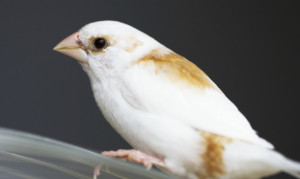
A songbird’s vocal muscles work like those of human speakers and singers, a study of Bengalese finches shows.
Each of the birds’ vocal muscles can change its function to help produce different parameters of sounds, in a manner similar to that of a trained opera singer.
“Our research suggests that producing really complex song relies on the ability of the songbirds’ brains to direct complicated changes in combinations of muscles,” says Samuel Sober, a biologist at Emory University and lead author of the study in the Journal of Neuroscience. “In terms of vocal control, the bird brain appears as complicated and wonderful as the human brain.”
Pitch, for example, is important to songbird vocalization, but there is no single muscle devoted to controlling it. “They don’t just contract one muscle to change pitch,” Sober says. “They have to activate a lot of different muscles in concert, and these changes are different for different vocalizations. Depending on what syllable the bird is singing, a particular muscle might increase pitch or decrease pitch.”
Previous research has revealed some of the vocal mechanisms within the human “voice box,” or larynx. The larynx houses the vocal cords and an array of muscles that help control pitch, amplitude and timbre.
Instead of a larynx, birds have a vocal organ called the syrinx, which holds their vocal cords deeper in their bodies. While humans have one set of vocal cords, a songbird has two sets, enabling it to produce two different sounds simultaneously, in harmony with itself.
“Lots of studies look at brain activity and how it relates to behaviors, but muscles are what translates the brain’s output into behavior,” Sober says. “We wanted to understand the physics and biomechanics of what a songbird’s muscles are doing while singing.”
The researchers devised a method involving electromyography (EMG) to measure how the neural activity of the birds activates the production of a particular sound through the flexing of a particular vocal muscle.
The results showed the complex redundancy of the songbird’s vocal muscles.
“It tells us how complicated the neural computations are to control this really beautiful behavior,” Sober says, adding that songbirds have a network of brain regions that non-songbirds do not.
The study was co-authored by Kyle Srivastava, a graduate student of the Emory and Georgia Tech Biomedical Engineering Doctoral Program, and Coen Elemans, a biologist from the University of Southern Denmark and a former visiting professor at Emory. The work was funded by the Emory Institute for Quantitative Theory and Methods and the National Institutes of Health.
Source: Emory University and Futurity.org




